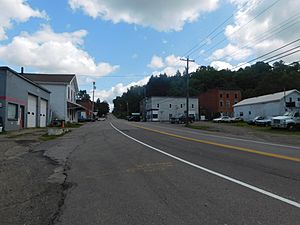Otto, New York facts for kids
Quick facts for kids
Otto, New York
|
|
|---|---|

County Route 12 in the hamlet of Otto.
|
|
| Country | United States |
| State | New York |
| County | Cattaraugus |
| Government | |
| • Type | Town Council |
| Area | |
| • Total | 32.28 sq mi (83.61 km2) |
| • Land | 32.16 sq mi (83.30 km2) |
| • Water | 0.12 sq mi (0.30 km2) |
| Elevation | 1,755 ft (535 m) |
| Population
(2020)
|
|
| • Total | 775 |
| • Estimate
(2021)
|
768 |
| • Density | 24.22/sq mi (9.35/km2) |
| Time zone | UTC-5 (Eastern (EST)) |
| • Summer (DST) | UTC-4 (EDT) |
| ZIP code |
14766
|
| Area code(s) | 716 |
| FIPS code | 36-009-55783 |
| GNIS feature ID | 0979331 |
Otto is a small town in Cattaraugus County, New York, United States. In 2020, about 775 people lived here. The town got its name from Jacob S. Otto, who worked for the Holland Land Company a long time ago. Otto is found on the northern edge of Cattaraugus County.
Contents
History of Otto
The first people settled in the Otto area around 1816. The town of Otto was officially created in 1823. It was formed from a part of another town called Perrysburg. Later, Otto gave some land back to Perrysburg in 1823. It also gave land to Ashford in 1835.
In 1854, the eastern part of Otto became its own town, called East Otto. The Medora Ball Historical Museum in Otto is a special building. It is listed on the National Register of Historic Places because of its importance.
Geography of Otto
Otto covers a total area of about 85.1 square kilometers (32.8 square miles). Most of this area is land, with only a small part being water.
The northern border of the town is formed by Cattaraugus Creek. This creek also marks the border with Erie County. The western border of Otto is formed by the South Branch of Cattaraugus Creek.
Roads in Otto
The main roads in Otto are county roads. Cattaraugus County Route 12 is the most important road. It goes southwest towards the town of Cattaraugus and northeast towards East Otto.
Other county roads include:
- Cattaraugus County Route 11 (North Otto Road) – This road goes north from the main village of Otto through an area called North Otto.
- Cattaraugus County Route 13 (Maples Road) – This road splits off east of the main village and heads towards Ellicottville.
- Cattaraugus County Route 68 (Swamp Road) – This road connects North Otto with East Otto.
Natural Areas
A part of the Zoar Valley is located near the northern border of the town. This is a beautiful natural area.
Neighboring Towns
Otto is surrounded by several other towns:
- Collins
 (to the north)
(to the north) - East Otto
 (to the east)
(to the east) - Mansfield; New Albion
 (to the south)
(to the south) - Persia
 (to the west)
(to the west)
Population of Otto
| Historical population | |||
|---|---|---|---|
| Census | Pop. | %± | |
| 1830 | 1,224 | — | |
| 1840 | 2,133 | 74.3% | |
| 1850 | 2,267 | 6.3% | |
| 1860 | 1,075 | −52.6% | |
| 1870 | 1,028 | −4.4% | |
| 1880 | 1,111 | 8.1% | |
| 1890 | 1,042 | −6.2% | |
| 1900 | 1,105 | 6.0% | |
| 1910 | 922 | −16.6% | |
| 1920 | 773 | −16.2% | |
| 1930 | 704 | −8.9% | |
| 1940 | 642 | −8.8% | |
| 1950 | 685 | 6.7% | |
| 1960 | 715 | 4.4% | |
| 1970 | 731 | 2.2% | |
| 1980 | 828 | 13.3% | |
| 1990 | 777 | −6.2% | |
| 2000 | 831 | 6.9% | |
| 2010 | 808 | −2.8% | |
| 2020 | 775 | −4.1% | |
| 2021 (est.) | 768 | −5.0% | |
| U.S. Decennial Census | |||
In 2000, there were 831 people living in Otto. There were 310 households, which means 310 groups of people living together. Most of these households (64.8%) were married couples. About 32.9% of households had children under 18 living with them.
The average age of people in Otto in 2000 was 40 years old. About 25% of the population was under 18.
Famous People from Otto
Some notable people have come from Otto:
- Anna Botsford Comstock – A leader in the nature study movement.
- John P. Darling – A former New York state senator.
- Edwin Willits – A former US congressman from Michigan and president of Michigan Agricultural College.
Communities and Places in Otto
- Otto (also known as "Waverly" in the past) – This is the main hamlet or village in the town. It is located near the southern border where County Roads 11 and 12 meet. Most of the town's population lives here.
- North Otto – This is an area with fewer people, mostly farms. It is located along County Road 11, between the hamlet of Otto and the Zoar Valley.
- (Old) Otto – This was the original village of Otto, but it is now an abandoned settlement. It is located on the western border of the town, along the South Branch of the Cattaraugus Creek.
- Zoar Valley Multiple Use Area – This is a special area for nature and conservation in the northern part of the town.
See also
 In Spanish: Otto (Nueva York) para niños
In Spanish: Otto (Nueva York) para niños


